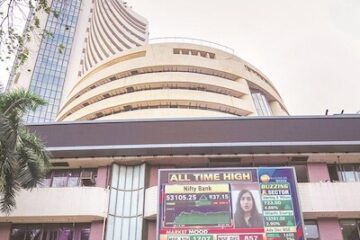The recent macro data from the US, which pointed to a cooling economy, has led to traders placing bets on rate cuts as early as June next year. The yield on the 10-year US Treasury fell from its multi-year highs and stood at around 4.6 per cent on Monday. Last month, the 10-year yields breached the 5 per cent mark for the first time in 16 years. The sharp spike in US yields saw the domestic markets tank as much as 5 per cent last month.
Last week, the Federal Reserve hinted that the recent rise in the 10-year US bond yields had reduced the need for further rate hikes. The Fed’s dovish comments rekindled hopes of its rate-hiking campaign ending and spurred an equity rally across the globe.
In the past two trading sessions, the selling pressure from overseas funds has been ebbing. On Monday, foreign portfolio investors (FPIs) sold shares worth Rs 550 crore, while domestic institutions pumped in nearly Rs 600 crore.
While softening US bond yields provide comfort to investors, some analysts warn against letting the guard down so early. If inflation proves to be stubborn or the economy shows more resilience, then there is a chance for bond yields to go up again, they warn.
“Inflation may be down, but it is not out. US bond yields may be lower on the week, but they are still higher than we have witnessed for many years,” said Gary Dugan, Chief Investment Officer at Dalma Capital.
The lack of any negative surprises in corporate earnings and robust macro numbers in India have also kept sentiment positive.
However, investors continue to be wary of the Israel-Hamas conflict and its impact on oil prices. Many fear the war in West Asia could snowball into a wider regional conflict involving Iran and other oil-producing nations, which could result in a spike in crude oil prices. So far, the oil market hasn’t seen any significant price disruption. The Brent crude was trading at $87 on Monday.
“The risk-on trade is back. But one cannot dismiss the Israel-Hamas conflict like Russia-Ukraine. There is still no clarity on whether it will turn into a wider conflict,” said Ambareesh Baliga, an independent equity analyst.
From now on, macro data from the US and China and the statements of Federal Reserve Chairman Jerome Powell and Bank of England Governor Andrew Bailey will determine the market trajectory.
The market breadth was strong with 2,422 stocks advancing and 1,381 declining. Barring four, all Sensex stocks advanced. ICICI Bank rose 1.3 per cent and contributed the most to Sensex gains, followed by Larsen & Toubro, which rose 2.3 per cent. State Bank of India, which declared its earnings on Saturday, fell 0.7 per cent, the most among Sensex components.
Resistance zone nears
From last week’s low, the Nifty has climbed over 570 points, or 3 per cent. Technical analysts said the index now faces resistance at 19,500 and 19,700 levels. “While technical analysis paints a favourable picture, the primary challenge remains the breach of the 19,707-resistance level, cushioned by robust support at 19,225,” said Prashanth Tapse, Senior Vice President (Research) at Mehta Equities. “The market is now advancing towards the next overhead resistance of around 19,550-19,600 levels in the short term. Immediate support is placed at 19,320 levels,” added Nagaraj Shetti, Technical Research Analyst at HDFC Securities.
Note:- (Not all news on the site expresses the point of view of the site, but we transmit this news automatically and translate it through programmatic technology on the site and not from a human editor. The content is auto-generated from a syndicated feed.))



